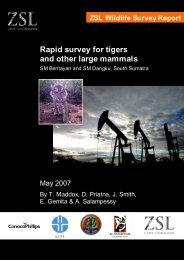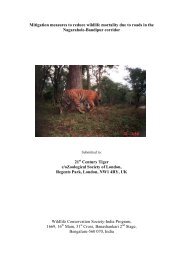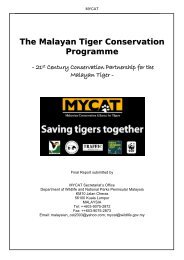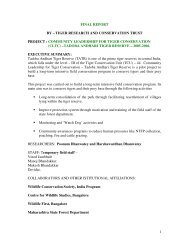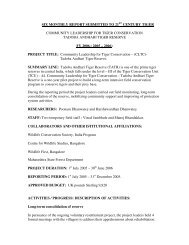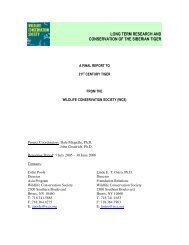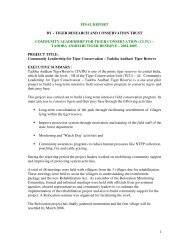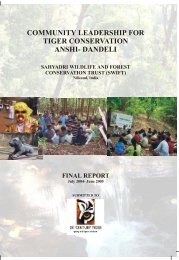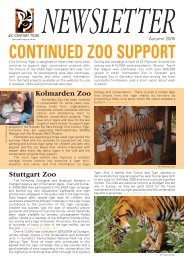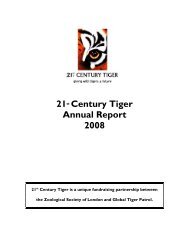The conservation of tigers and other wildlife in oil palm plantations
The conservation of tigers and other wildlife in oil palm plantations
The conservation of tigers and other wildlife in oil palm plantations
Create successful ePaper yourself
Turn your PDF publications into a flip-book with our unique Google optimized e-Paper software.
RECOMMENDATIONS<br />
Mitigat<strong>in</strong>g the impacts <strong>of</strong> <strong>oil</strong> <strong>palm</strong> <strong>plantations</strong> on <strong>wildlife</strong><br />
Mitigate impact <strong>of</strong> new plant<strong>in</strong>g through <strong>wildlife</strong> surveys<br />
M<strong>in</strong>imis<strong>in</strong>g impacts by plant<strong>in</strong>g <strong>in</strong> low impact areas is already a recognised strategy,<br />
with the RSPO recommend<strong>in</strong>g no plant<strong>in</strong>g <strong>in</strong> areas <strong>of</strong> high <strong>conservation</strong> value (RSPO,<br />
2006). However, the results from this study show that exist<strong>in</strong>g def<strong>in</strong>itions <strong>of</strong> low<br />
impact areas or degraded habitats are fail<strong>in</strong>g to capture a great deal <strong>of</strong> <strong>conservation</strong><br />
value. Rather than a simple choice <strong>of</strong> “forest/good” or “non-forest/bad”, the<br />
<strong>conservation</strong> value <strong>of</strong> degraded l<strong>and</strong> needs to be assessed on a slid<strong>in</strong>g scale. It is not<br />
enough to simply say plant<strong>in</strong>g must not happen <strong>in</strong> protected areas or forest because<br />
many apparently degraded areas reta<strong>in</strong> high value for some species <strong>and</strong> need urgent<br />
<strong>conservation</strong> attention.<br />
<strong>The</strong> first recommendation is therefore that <strong>wildlife</strong> surveys are carried out before any<br />
plant<strong>in</strong>g is carried out or irrevocable decisions on l<strong>and</strong> use are made. <strong>The</strong>se have to<br />
be active field surveys, not surveys <strong>of</strong> exist<strong>in</strong>g data or expected results as can be<br />
sufficient for AMDALs (required environmental audits), <strong>and</strong> they must be carried out<br />
us<strong>in</strong>g scientifically robust methods. Initial surveys would not have to be lengthy or<br />
difficult – establish<strong>in</strong>g presence/absence <strong>of</strong> various species would be sufficient.<br />
However, for areas where <strong>in</strong>itial surveys <strong>in</strong>dicate the presence <strong>of</strong> <strong>conservation</strong> values,<br />
more detailed work will be needed to determ<strong>in</strong>e the level <strong>of</strong> value.<br />
Furthermore, it would also be important to have the results viewed by an <strong>in</strong>dependent<br />
body that can analyse them <strong>in</strong> a l<strong>and</strong>scape context. Degraded l<strong>and</strong> marked for<br />
development will more <strong>of</strong>ten have potential as connect<strong>in</strong>g or transitional habitat than<br />
as high value habitat <strong>in</strong> its own right. However, evaluat<strong>in</strong>g the importance <strong>of</strong> an area<br />
<strong>in</strong> terms <strong>of</strong> connectivity is only possible from a l<strong>and</strong>scape perspective, us<strong>in</strong>g<br />
<strong>in</strong>formation unlikely to be available to most <strong>plantations</strong>. <strong>The</strong> RSPO approach <strong>of</strong><br />
avoid<strong>in</strong>g HCVF is a strong step <strong>in</strong> the right direction. However, HCVF <strong>in</strong> its orig<strong>in</strong>al<br />
form is a tool for forest certification, not for overall l<strong>and</strong>-use plann<strong>in</strong>g, ie identify<strong>in</strong>g<br />
areas suitable or unsuitable for <strong>oil</strong> <strong>palm</strong> <strong>and</strong> <strong>other</strong> agricultural or <strong>in</strong>dustrial<br />
development. It is therefore important that the HCV pr<strong>in</strong>ciple is applied to non-forest<br />
habitats, <strong>and</strong> that a clear <strong>and</strong> appropriate def<strong>in</strong>ition <strong>of</strong> HCV is <strong>in</strong>corporated <strong>in</strong>to the<br />
RSPO guidel<strong>in</strong>es.<br />
Mitigate impacts <strong>of</strong> exist<strong>in</strong>g <strong>plantations</strong> through management<br />
<strong>of</strong> unplanted l<strong>and</strong><br />
Wildlife refuges<br />
One option is to leave one or two parcels <strong>of</strong> l<strong>and</strong> with<strong>in</strong> the plantation (as opposed to<br />
on its boundaries/adjacent to <strong>other</strong> possible <strong>wildlife</strong> habitats) unplanted as <strong>wildlife</strong><br />
refuges, or small <strong>conservation</strong> areas. This option is only likely to have value if the<br />
plantation conta<strong>in</strong>s areas <strong>of</strong> <strong>in</strong>tr<strong>in</strong>sically high <strong>conservation</strong> value – a particular type <strong>of</strong><br />
habitat or area used specifically by a certa<strong>in</strong> species (such as a nest<strong>in</strong>g site). <strong>The</strong><br />
benefits <strong>of</strong> this practice are constra<strong>in</strong>ed by available space. Even if a plantation<br />
allocates a relatively generous 15% <strong>of</strong> its l<strong>and</strong> to a s<strong>in</strong>gle <strong>wildlife</strong> refuge, the area is<br />
rarely likely to exceed several hundred hectares. An isolated piece <strong>of</strong> habitat <strong>of</strong> this<br />
size is only likely to have a significant value for smaller mammal species such as<br />
pangol<strong>in</strong>s, porcup<strong>in</strong>es <strong>and</strong> <strong>other</strong> rodents, small primates, viveridae (civets, badgers)<br />
<strong>and</strong> also <strong>other</strong> small or mobile taxa such as birds, reptiles, amphibians <strong>and</strong> <strong>in</strong>sects.<br />
Larger species with some tolerance to <strong>oil</strong> <strong>palm</strong> <strong>and</strong> hence the ability to move through<br />
it could also benefit by us<strong>in</strong>g such areas as temporary shelter with<strong>in</strong> a larger range –<br />
deer species, bears or macaques could all benefit for example. However, the chances<br />
<strong>of</strong> support<strong>in</strong>g viable populations <strong>of</strong> large, <strong>oil</strong> <strong>palm</strong> <strong>in</strong>tolerant species such as tapir <strong>and</strong><br />
<strong>tigers</strong> with<strong>in</strong> such areas are pretty much non-existent. F<strong>in</strong>ally, if large tracts are to be<br />
Wildlife <strong>conservation</strong> <strong>in</strong> <strong>oil</strong> <strong>palm</strong> <strong>plantations</strong> 47




